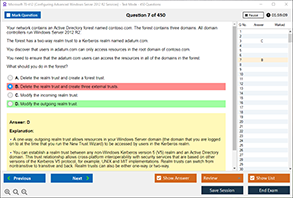Introduction
In modern networking, data transmission is crucial for maintaining the flow of information across various devices and networks. The process of data delivery involves using specific logical addresses that help ensure that data reaches its correct destination. Among the various types of addressing used in networking, the logical address plays a significant role in the delivery of data to remote networks. A logical address is used to identify a device or network segment in a way that is independent of the physical hardware.
In this blog post, we will delve into the concept of logical addresses, particularly focusing on the logical address used for the delivery of data to a remote network. This discussion will cover the importance of logical addressing in network communication, the different types of logical addresses, and the specific logical address used for routing data between networks. By the end of this article, you will have a clear understanding of how logical addressing ensures seamless data delivery in a networked environment.
What is a Logical Address?
A logical address is an address that is used to identify devices or network segments within a larger network. Unlike physical addresses, which refer to hardware components such as network interface cards (NICs), logical addresses allow for flexibility in data transmission across different types of networks. Logical addresses are typically assigned by network administrators or automatically configured through dynamic host configuration protocol (DHCP).
In IPv4 (Internet Protocol version 4), the logical address is known as an IP address (Internet Protocol address), while in IPv6, the concept is similar, with a more extended format. These logical addresses help route data across various network segments, ensuring that packets of data are delivered to the correct destination, even if the data must pass through multiple intermediate devices like routers.
Types of Logical Addresses in Networking
-
IP Address (IPv4): The most commonly used logical address in today’s networks is the IP address. It uniquely identifies a device on the network and is crucial for routing data between devices on local and remote networks. The IPv4 address is a 32-bit address expressed in four octets (e.g., 192.168.1.1), allowing for around 4.3 billion unique addresses.
- Private IP Address: Used for communication within a local network and not routable over the internet.
- Public IP Address: A globally unique address that can be routed over the internet.
-
IP Address (IPv6): IPv6 is the successor to IPv4, designed to address the exhaustion of available IPv4 addresses. It uses a 128-bit address format and provides a vastly larger address pool, allowing for a practically unlimited number of unique addresses. IPv6 addressing is written in hexadecimal, and its format is significantly longer than IPv4.
-
MAC Address: While not a logical address in the typical sense of routing data between remote networks, the MAC (Media Access Control) address is a physical address used in the data link layer. This address uniquely identifies devices on a local network segment, helping to ensure correct delivery within that segment.
The Role of Logical Addresses in Data Delivery
The primary function of a logical address in networking is to identify the source and destination devices or networks, ensuring that data packets are routed correctly across intermediate devices. In the case of remote networks, the logical address plays a key role in determining how data will travel across multiple network segments, possibly involving several routers.
When a device wants to send data to a remote network, it uses the destination IP address in the packet header to ensure that the data reaches the correct destination. Routers in between examine the destination address and determine the best path for the data, forwarding it from one network to another until it reaches the final destination.
Logical addresses like IP addresses are used in combination with routing protocols, such as RIP (Routing Information Protocol), OSPF (Open Shortest Path First), and BGP (Border Gateway Protocol), to dynamically determine the best path for data delivery. These protocols ensure that the data can reach its destination even if there are network failures or changes in the routing path.
How Logical Addresses Facilitate Remote Network Communication
-
Routing Between Networks: The process of data delivery from one network to a remote network relies on routers, which use logical addresses to forward data. When a device on one network communicates with a device on another network, the data must pass through routers that examine the destination IP address to determine the correct path for the data.
-
Packet Switching: Logical addresses are used in packet-switched networks, where data is broken down into smaller packets. Each packet contains the destination IP address, and routers use this address to forward the packet to the correct next hop in the network. This process continues until the packet reaches the destination.
-
Network Address Translation (NAT): In some cases, private networks use NAT to communicate with remote networks. NAT maps a private IP address to a public IP address, allowing devices within a private network to communicate with devices on remote networks using a single public IP address. This is particularly common in home and enterprise networks, where devices are behind a router with a single public IP address.
The Logical Address Used for Delivery to a Remote Network: The IP Address
When it comes to delivering data to a remote network, the logical address most commonly used is the IP address. Specifically, the IP address is used to identify devices and networks and to route data from one network to another, ensuring that it reaches its final destination.
- IPv4 Addresses: As mentioned earlier, IPv4 addresses are still widely used for remote network communication. Routers analyze the destination IPv4 address to determine how to forward data between networks.
- IPv6 Addresses: With the growth of the internet and the exhaustion of IPv4 addresses, IPv6 was introduced to provide a much larger pool of addresses. IPv6 addresses play the same role as IPv4 addresses in routing data to remote networks but provide a larger address space to accommodate the increasing number of devices connected to the internet.
Example of Logical Addressing in Action
Let’s say you are using a device with the IP address 192.168.1.100, and you want to access a website hosted on a server with the IP address 203.0.113.50. Here’s a step-by-step breakdown of how logical addressing works:
- Device A (192.168.1.100) sends a data packet to the server (203.0.113.50).
- The data packet contains the destination IP address (203.0.113.50) and is forwarded to a router.
- The router examines the destination IP address and forwards the packet to the appropriate next hop.
- The packet travels through multiple routers across different networks, each router using the destination IP address to determine the next hop.
- Eventually, the packet reaches the remote server, where it is processed and a response is sent back to Device A.
Conclusion
In conclusion, the logical address used for the delivery of data to a remote network is primarily the IP address. Whether using IPv4 or IPv6, these addresses play a crucial role in ensuring that data reaches its correct destination, passing through various routers and network segments along the way. Understanding how logical addressing works is fundamental for networking professionals, as it forms the backbone of network communication.
As networks continue to grow and evolve, the importance of logical addressing will only increase. With the ongoing adoption of IPv6, the future of logical addressing promises even more scalability and flexibility, enabling seamless communication across global networks.
Free Sample Questions
Which logical address is used to route data between remote networks?
A) MAC address
B) IP address
C) Port number
D) Subnet mask
Answer: B) IP address
What is the primary function of a logical address in networking?
A) To uniquely identify a device on the local network
B) To specify the physical location of a device
C) To identify a device or network for data routing
D) To control the flow of data within a device
Answer: C) To identify a device or network for data routing
Which of the following protocols helps in routing data using logical addresses?
A) DHCP
B) DNS
C) OSPF
D) ARP
Answer: C) OSPF



